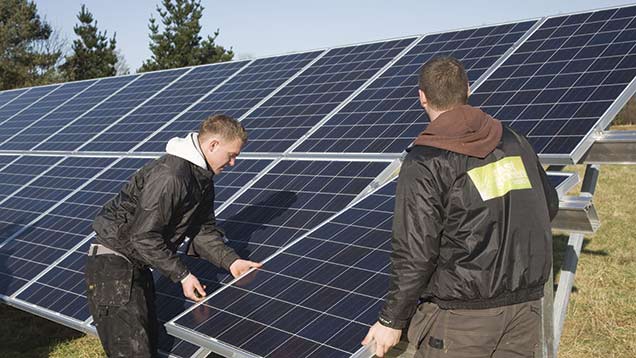Solar power shines in record year for renewables…
 © Eco Images/UIG/Rex
© Eco Images/UIG/Rex Renewable energy generation overtook that of nuclear power to hit a record 64.4 terawatt-hours (TWh) last year, equivalent to 19.2% of total UK energy generation.
Department of Energy and Climate Change (DECC) figures have revealed that solar PV was the fastest growing of all technologies in 2014. Capacity rose by 2.4GW during 2014, following growth in large-scale sites under the Renewables Obligation (RO) as well as increases in small scale Feed-in Tariffs (FiT) sites. Capacity on the FiT scheme represented 55% of total solar deployment.
…but can growth continue?
However, ongoing cuts to FiT payments – the latest of which took effect on 1 April – ending of the RO for large-scale solar and lack of clarity about renewables policy post-election means there is increasing uncertainty about future growth of the sector.
See also: Solar rents hold firm as developers chase sites
The UK has fallen to its lowest position in 12 years on Ernst & Young’s quarterly Renewable Energy Country Attractiveness Index, behind France, Canada and India.
The index, which is topped by China, US and Germany, measures how attractive different countries are to invest in renewables and it is the fourth successive time the UK has fallen down the rankings.
The report blames concerns that “the UK’s new contract for difference (CfD) regime [for solar projects larger than 5MW] will not provide sufficient certainty to stimulate investment in new projects and the commitment of development expenditure”.
Lifting solar red tape
Although there is some political uncertainty for now, demand is still strong for land to lease for ground-mounted solar projects (FW, Business, 13 March). The government has also provided some encouragement to the solar sector with two recent regulatory changes.
Plans to allow rooftop installations up to 1MW to be built under permitted development rights come into effect next week (15 April) and, after a consultation last winter, DECC has also given the go-ahead for building-mounted solar PV installations to be moved without jeopardising Feed-in Tariffs payments.
DECC recognised the current requirement to keep a FIT-accredited solar installation in the same place for the 20-year duration of payments deterred deployment, so agreed to change the rules for other-than-stand-alone solar PV installations greater than 50kW. However, it said no transfers would be allowed until four years after the legislation had come into force, likely to be later this year.
Permitted development for solar
It is hoped that the changes to permitted development rules (PDRs) announced at the end of March will ease the regulatory burden on larger rooftop schemes. This removes the need to go through the full planning process and may remove an artificial barrier to installation size – previously PDRs were only available on projects of up to 50kW.
There is still some uncertainty about how much local authorities will charge for the PDR application, as charges are set by central government, but Strutt & Parker’s Alexander Creed expects fees to be similar to current levels for other prior notifications, typically between £80 and £400.
“Planning was not an issue before [for rooftop solar projects], we have never had one turned down and all have been granted by delegated powers by planning officers. It will hopefully encourage more projects to progress as it will reduce the time required before an install can start and the application process should be simpler and hence all round cheaper.”
Local authorities will have to consider the impact of glare from proposed arrays under the new rules, but Mr Creed said this should not be an issue for rooftop systems, which were higher in the air than ground-mounted arrays, often at a lower angle (15 degrees v 25 degrees) and in smaller blocks of panels.
“Full glare studies are often submitted for solar farm applications but my view is that they would be a sledgehammer to crack a nut and the cost would be too high and undo the benefit of this change to planning. I hope the approach we have seen to date with planning applications continues and that this does not become an issue.”
